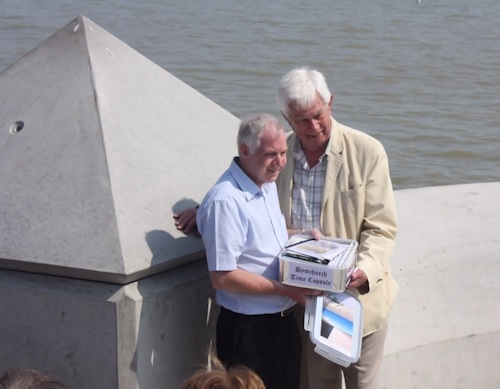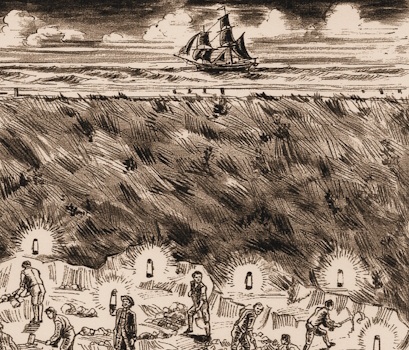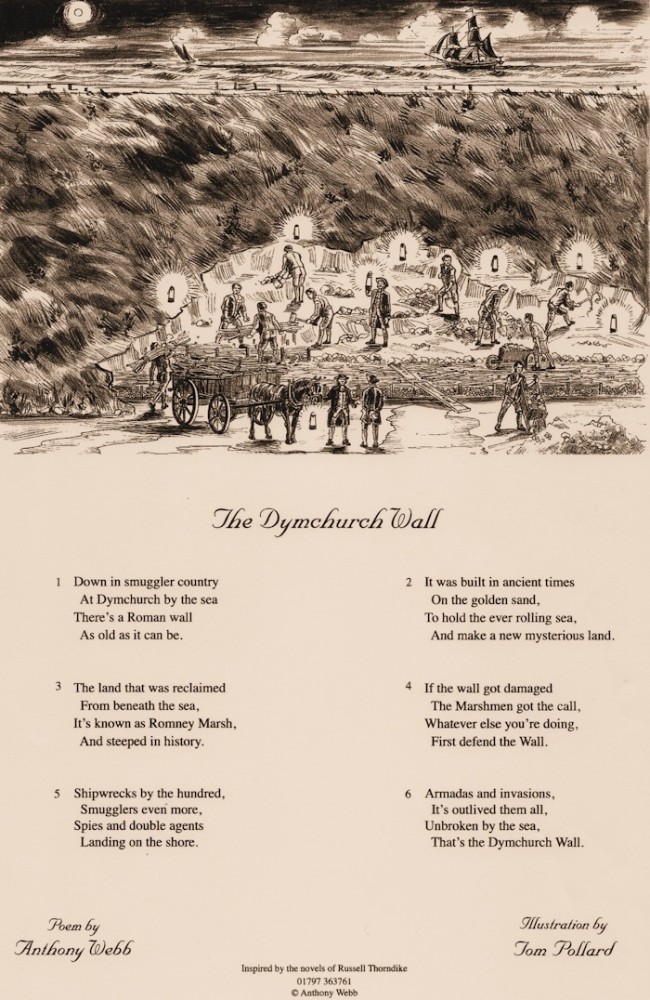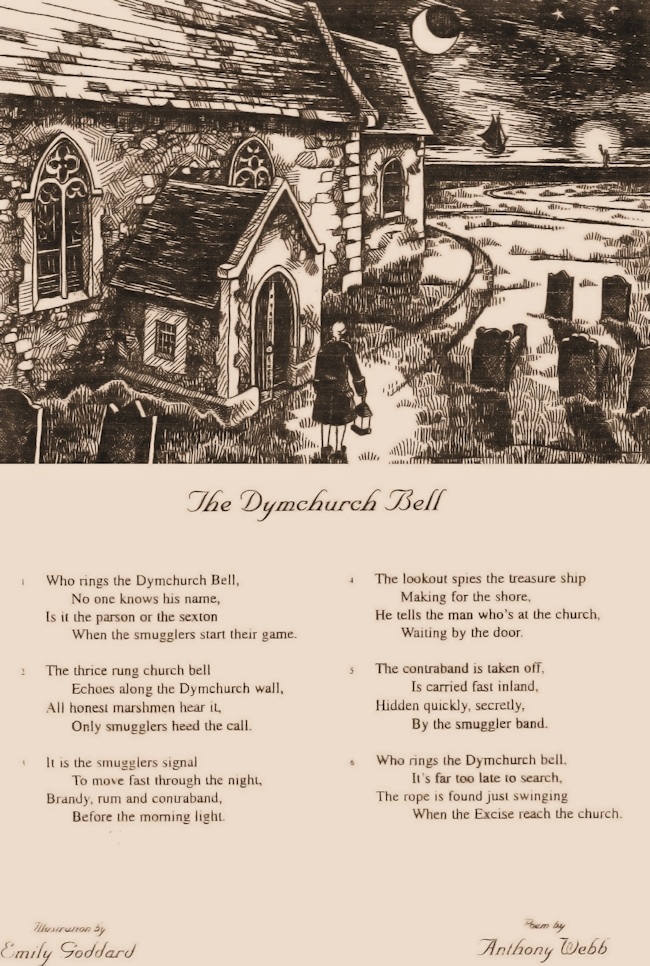Dymchurch Wall
Approximately half of the present coastline of the Romney Marsh area is defended by sea walls, the oldest of which is the Dymchurch Wall. The majority of the marsh is below mean high tide level so without the protection of the sea wall the land would be under water much of the time. Land levels in Romney Marsh are about 2 to 3 metres above Ordnance Datum Newlyn (which is the mean sea level to which all levels in the country are related), however near Snargate the levels are about 0.3 metres. In Walland Marsh, the levels vary between 1 metre at Fairfield to about 5 metres at Lydd and Midley.
An apt slogan for Romney Marsh, penned by author Russell Thorndike in his Dr Syn novel, 'The Scarecrow Rides'
It epitomises the fact that Romney Marsh owes its existence to the Dymchurch Wall,
which stops the sea from flooding the Marsh.

Dymchurch has had a seawall since Roman times, with the original development being constructed to protect the harbour at Port Lympne, and then continuing throughout the centuries to help protect the Marsh itself.
Up to the 13th century, the shingle barrier protecting the coast at this point had withstood many storms. However, after the three great storms of 1236, 1250-2 and 1287-8, some of the massive shingle bank which previously formed the eastern seaboard of Romney Marsh moved southward, but most of it moved away north-eastward, filling Hythe Haven (now Hythe Ranges) and travelling on towards Folkestone. As the shingle bank diminished so the construction of one of the world's great sea walls began - using clay dug from the land close behind it, armed on its seaward face with wood piles and faggots, and with rock groynes (knockes, relayes, slattes, groynes and fothegges) projecting into the sea to hold the shingle.
The starting date of construction of Dymchurch Wall is not known - it was probably late in the 13th century - and the wall was certainly of great importance by the mid-16th century. By 1803 the condition of the wall, about 4 miles in length and approximately 20ft high, was so bad that an outside engineer was called in to advise and he caused the front slope, previously almost vertical, to be set back to about 6 to 1 by throwing the crest inland. Whether or not he advised the use of rock to protect the front face is uncertain, but the first purchase of Kentish Ragstone for this purpose, quarried from the hills behind Hythe, is recorded in 1825. Find out more
The Dymchurch Wall, together with the Rhee Wall erected between New Romney and Appledore, ensured that the rich alluvial land deposited by the river Limen (Rother) which had initially been used as salt pans, slowly became rich and fertile farmland.
Inscription on the Plaque on the Present Sea Wall
Roman pottery found in the wall during the 19th century by the engineer James Elliott suggests that the wall might first have been built by the Romans.
During the 13th century storms, battered Dymchurch and the maintenance of the wall became the responsibility of The Corporation of Romney Marsh. In the 15th century, a "Scot Tax" was levied on every landowner on Romney Marsh for continuing repair of the wall. If your property was above the sea level you got off "Scot Free".
In 1705 a special meeting was held to survey the damage done by an extraordinary tide, "unknown since the memory of man". They decided to transport earth and branches from across the Marsh to repair breaches. In 1803, John Rennie (builder of the Waterloo, Southwark and London bridges) recommended the construction of a three-mile concrete and Kentish ragstone wall - the beginnings of the modern day wall.
Over the next two centuries, a constant battle against the elements culminated in the reconstruction of the wall completed in 2011.
Hasted described the wall in 1799 (see below) as being made of "a continued raddle-work of overlaths and faggots, fastened to rows of piles in ranges of three feet width, parallel with the wall, one above the other."
Such was the need for these faggots that thorn trees were specially grown in the Marsh as a source of supply, and no tree could be cut for any other purpose unless first certified as being useless for the wall.
Faggotters were employed by the Corporation under strict rules of engagement, and there were penalties for failure to deliver the goods.
In addition, a labour force of up to sixty men was employed full-time on the wall, and many more were engaged from time to time for particular tasks. A Sergeant of the Woods was responsible for the supply of timber for piling, and some areas, such as Lympne Park, were leased, from time to time, specially for growing timber for the wall.
It was in the first half of the nineteenth century that stone was brought into use on the seaward slope. The wall was then steadily extended both in height and width, with the widespread improvements undertaken in 1894.
Text courtesy of The Fifth Continent: The Story of Romney Marsh and its Surroundings by Duncan Forbes
Edward Hasted in his Parishes: Dimchurch', in The History and Topographical Survey of the County of Kent: Volume 8 published in 1799, described the Dymchurch Wall as follows:
This wall is usually known by the name of Dimchurch wall, and is about three miles in length, extending from Brockman's barn, eastward of this place, as far westward as Wallend, about a mile and an half from New Romney.
As it is for the common safety, so it is supported by scots levied over the whole marsh, and the yearly expence of it is very great indeed, to the amount of 4000l. as the sea has lately increased with unusual force against it, insomuch as to call for every exertion for its preservation.
It is more than twenty feet in height, and as much in width at the top, the high road from Hythe by Dimchurch to New Romney being along the summit for the greatest part of the length of it, and at the base it may be said to extend upwards of three hundred feet, being defended outward, down the sloping bank of it towards the sea, by a continued raddle work of overlaths and faggots, fastened to rows of piles in ranges of three feet width, parallel with the wall, one above the other, for a considerable way; and across contrariwise by numbers of iettees, knocks, and groins, from the wall towards sea, at proper distances, along the whole of it, to weaken the force of the waves, and at the same time stop the beach and shingle stones, which are continually thrown up, and to lodge them among the works, on the sides of the wall, as an additional covering and strength to it.
Through the wall are three grand sluices, at proper parts of it, for the general sewing of the Marsh.
On 20 July 2011, a new sea wall, built at a cost of £60 million, was officially opened by the Rt. Hon. Lord Smith of Finsbury, Chairman of the Environment Agency. He announced that "the scheme was implemented by the Environment Agency as part of the wider Folkestone to Cliff End Sea Defence Strategy, the sea defence project which will protect 2,500 properties from flooding. The high cost of flooding underlines the importance of investment in reducing flood risk."He also added "The agency said storms and raised sea levels are due with climate change."
The scheme included reinstatement of groynes which had fallen into disrepair.
The new wall allows pedestrians to walk the sea shore for the entire length of the village, approximately four miles, from Hythe Military Rifle Ranges in the East to St Mary's Bay Boundary in the West. Cyclists have the same freedom but must dismount for about 500m around the area of the public amenities.
![]() more information
more information

Dymchurch Wall 2012
To mark the completion of the building of the new sea wall, on 20 April 2011, a Dymchurch Time Capsule was placed inside one of the pillars on the new sea wall.
The Dymchurch & District Heritage Group and Dymchurch Parish Council co-ordinated the items to be encapsulated.
The capsule, which is 30cm (12in) square and 20cm (8in) deep, contains 61 items and 150 postcards with messages from local people and school children. Some of the items included memorabilia from the parish council and local churches, a mobile phone, coins, maps, two poems and a menu from the local Chinese takeaway. The capsule will be left untouched for 100 years, until July 2111.
Colin Walker from the Heritage Group said: "It's been great for so many people to be involved and we can give an insight into life in Dymchurch today to the people of the future."
Poems Placed in the Time Capsule
Greatstone poet Anthony Webb has written many poems about Romney Marsh and the two poems, below, about the Dymchurch Wall and smuggling, were chosen to be included in the time capsule.
You can read more of the poems by Anthony at Anthony Webb Soldier turned Poet

John Rees, Herald Newspaper and Colin Walker, Dymchurch
Heritage Group, display the Time Capsule (Ack.22)





















